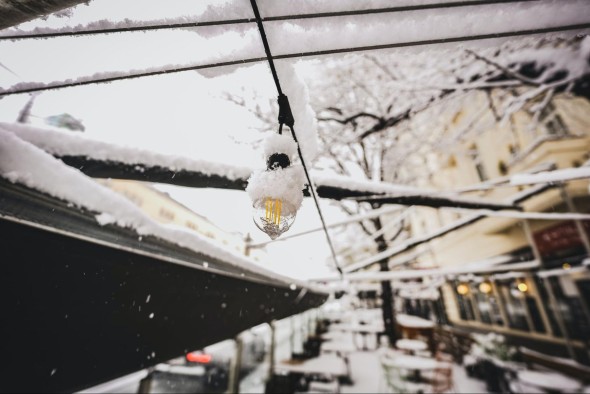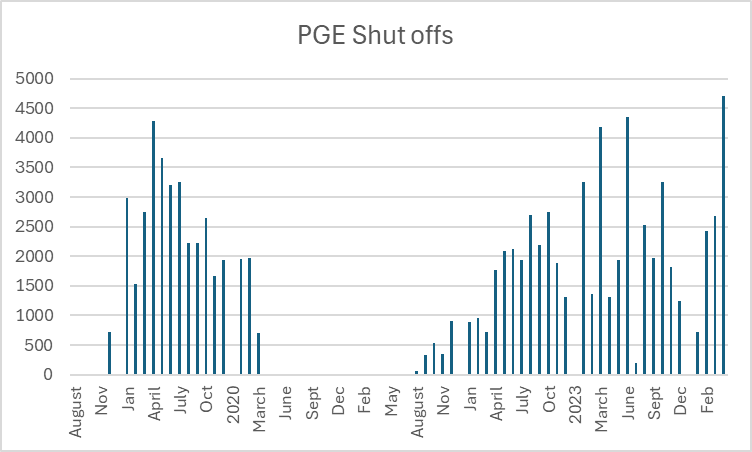Shut-Offs Surge While Profits Soar
Posted on May 28, 2024 by Bob Jenks
Tags, Energy, General Interest

The fallout from PGE’s big rate hike in January continues. Portland General Electric (PGE) shut-offs soared in April, reaching the highest monthly level since public reporting began in 2018.
A lot of attention was focused on PGE last January when customers experienced record bills, extended outages, and cold weather. Now, a few months later, the effects are becoming clear.
Lasting Impacts from January’s Ice Storm
More than 4,700 households were shut off in April of this year because of non-payment. By comparison, April 2023 saw 1,313 households disconnected from their electricity. Bills going out on Feb 1 would contain January’s usage, including soaring bills from the 2024 ice storm. Customers have 60 days to pay bills, so shut-offs in April are a direct consequence of January bills and the ice storm.
PGE raised rates by 18% on January 1. This also means that February bills were higher from both freezing temperatures and these new billing rates.
Record Bills Lead to Record Disconnections
The combination of significantly higher rates and a week of cold weather sent utility bills through the roof. This led to a customer backlash on social media. Many PGE customers were reporting record bills, bills that were more than $100 greater than typical winter bills.
Customers were saying that they could not afford their bills. Too many people had to choose between food, medicine, and heat. Thousands of families have now seen these unaffordable bills lead to a disconnection from utility service.
In 2018, the PUC started requiring utilities to report how many customers were disconnected each month. The level from last month is the highest level that has ever been reported.

Description: PGE Shut Offs, 2018-2024
Of the more than 4,700 households that were cut off from electricity in April, 756 homes (16%) were disconnected for more than 7 days. More than 40 of those customers were recipients of energy assistance funds. And 10 people with medical certificates lost power, despite the demonstrated need for electricity for health reasons.
Many Customers Already Went Without Electricity in January
When the January storm hit and thousands lost power, there were a lot of complaints about PGE’s response. Customers were reporting that PGE’s outage management system was not reflecting the outage at their homes. They reported that it was taking days to get power restored.
“This particular power outage felt life-threatening with indoor temperatures reaching below 40F and no end in sight.”
- Missy, PGE Customer
CUB asked PGE customers to share their experiences during the ice storm. Missy, a PGE customer in Portland shared:
“My family was without power for three days during this ice storm. It was honestly one of the worst experiences we have ever had to endure living in Portland. The electricity continues to go out for 24+ hours each year and it’s getting substantially worse with each passing year. This particular power outage felt life-threatening with indoor temperatures reaching below 40F and no end in sight.
I was unable to speak to someone from PGE because their phone lines had “technical difficulties.” Their outage map was unacceptable as a replacement for communication because it failed to provide any updates (many of which weren’t even accurate). We watched 150,000 outages decrease down to 30,000 with no restoration date/time provided for us.
I eventually had to make the call to evacuate my family to a hotel. This was our first time having to evacuate our home! As one of the last areas to get power restoration living in Powellhurst-Gilbert, of which ~47% of residents are BIPOC, I’d like to know whether PGE prioritized affluent, predominantly white neighborhoods.”
Profits vs. People
PGE Shareholder Profits Are Up
While it’s been a difficult year for PGE customers, it is a wonderful time for PGE shareholders. PGE had a net income of $109 million in the first three months of the year, up from $74 million in 2023.
For shareholders, earnings per share increased by more than 50%, from 80 cents per share to $1.21 per share. It provided PGE with a great story to tell investors and put PGE in a good position to meet its profit targets for the year. In addition, PGE announced that their targets for new capital investment over the next 4 years had increased by $1.3 billion over what they were in April 2023, suggesting even higher profits in future years.
The great results for PGE shareholders and the grim results for customers are two sides of the same coin. The combination of much higher rates and cold weather increased sales, providing more income for the company and its shareholders. It also helps explain why PGE is always timing its rate increases for the middle of winter. It is when customers use the most power, and the increase will provide the largest increase in revenue. It allows PGE to start the year with a positive message to shareholders.
Shutoffs are Devastating for Households
When a home’s electricity gets shut off, it can very easily cause a cascading effect for that family. We use energy in so many ways in our home: physical safety and comfort, food safety, communication, healthcare, entertainment, and more. Losing power comes with many hidden costs, especially for low-income households who can least afford these expenses.
For those with medical conditions that require electricity, a shutoff can be life-threatening. Losing power to a medical device or heating/cooling can quickly turn into an unsafe situation. Safely storing medicine that requires refrigeration is also impossible, forcing people to replace expensive prescriptions like insulin.
Losing power also means losing refrigeration for food. Having to replace a refrigerator full of food is incredibly expensive. This can force a household to choose between buying new groceries and restoring power. For many low-income families, losing power can be devastating to their budgets outside of just the energy expenses.
If not reversed, shutoffs can also cause families to lose their housing entirely. Without electricity, renters can be evicted. Even if you own your home, living without power can be grounds to lose ownership. Oregon is already facing a housing crisis.
As PGE disconnected over 4,700 households in April, each family had to deal with these consequences. When considering that more than one person lives in many Oregon homes, we’re looking at upwards of 11,500 Oregonians who lost their electricity, just in April.
More Rate Increase Could Come in 2025
Amidst all of these record bills and soaring shut-offs, PGE is asking for another rate increase. PGE is requesting an increase of $202 million or 7.2% for residential customers on January 1, 2025.
The utility company said in a statement to the press that it wants to “raise customers’ rates so that it can make investments in battery storage and other infrastructure improvements.” CUB’s review has found that the increase is unnecessary and PGE’s claims about it are misleading.
Thousands of PGE customers are still reeling from the rate increase and ice storm bills this January. PGE’s rates for Oregon households have already gone up by 30% from December 2022 to January 2024. Now is not the time to request even more from Oregon households.
Stay Up to Date on Oregon Utility Issues
CUB will continue to advocate for people in Oregon on major utility issues. Sign up for the CUB email list for the latest updates, action alerts, and news on policies that affect the utilities your home relies on.
To keep up with CUB, like us on Facebook and follow us on Twitter!




08/22/24 | 0 Comments | Shut-Offs Surge While Profits Soar